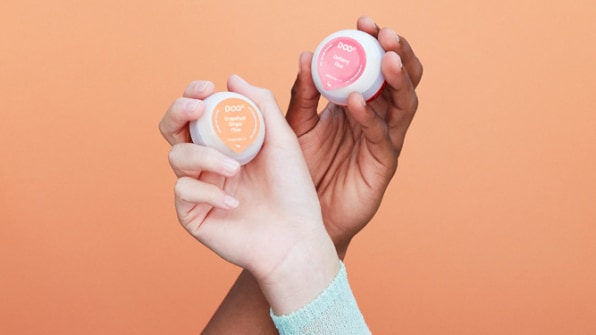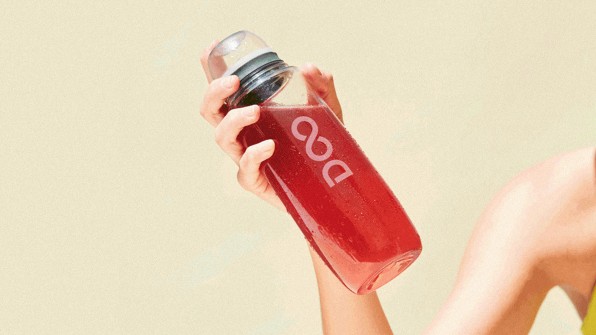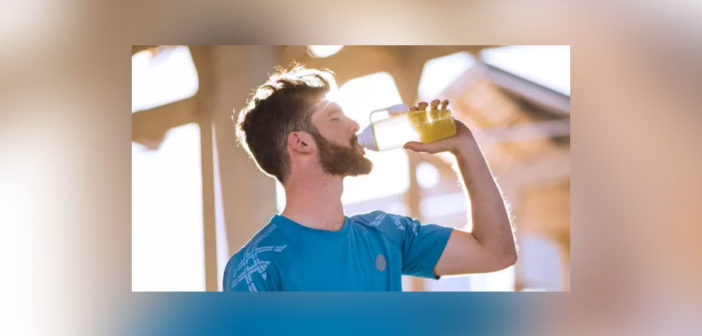In an attempt to provide more–and healthier options–PepsiCo is unveiling a new beverage system that the company likens to a modern-day soda fountain.
![[Photo: PepsiCo]](https://images.fastcompany.net/image/upload/w_562)
PepsiCo wants to rethink how and what consumers drink–and it has invented an entirely new system to give people a healthier alternative to soda. The company’s newest venture is centered on a 20-ounce reusable water bottle that comes with sets of flavor pods.
Each pod features combinations of wet ingredients, mostly different fruit juices, and dry ingredients, like pieces of ginger, vitamins, lemongrass extracts, and even oats. The company says all the ingredients are natural and there are no artificial sweeteners. The pods, which contain two ounces of liquid, range from 30 to 80 calories each. With the variety of flavors and emphasis on trendy superfoods, Drinkfinity is primed to tap into the billion-dollar health and wellness market, and could potentially appeal to soda drinkers trying to kick the habit.
The system’s sustainability is one of the driving forces behind the design. To create Drinkfinity, PepsiCo had to rethink the supply chain, manufacturing, shipping, and even recycling. That resulted in the full life cycle of a single pod producing 40% fewer carbon emissions than the typical 20-ounce drink housed in a plastic bottle you’d buy at the supermarket. The pods also use 65% less plastic than these 20-ounce bottles. Whether or not PepsiCo succeeds in drawing customers, Drinkfinity offers an inside look at how a major beverage company rethinks its design and production systems to meet shifting consumer tastes.

A NEW APPROACH FOR PEPSI
Vice president of global business innovation Hernan Marina first conceived of Drinkfinity in 2009, when the company was looking for a way to answer changing customer priorities around sustainability, health and wellness, customization, and choice. But instead of relying on the typical modes of development within a multinational corporation, which involve extension market research, focus groups, and a single product that’s honed to perfection before it’s launched internationally with a large marketing effort, PepsiCo decided to try something different.
After the initial idea, Marina formed an internal startup with a small team that worked out of a coworking space outside of the PepsiCo office. The focus was on prototyping, and the team went through hundreds of attempts at the water bottle–what they call the “vessel”–and the pods, all with the input of a group of international consumers who would give feedback on every round. After building a new manufacturing line from scratch because previous machines weren’t equipped to make containers the size of the pods, the team launched a pilot program in Brazil in 2014. At the time, you would pop the pod into the bottle, but this caused leaks and the bottle design had too many parts, making it difficult to clean. Marina’s team switched to a top-loading bottle design before doing an internal beta test in 2017 with 4,000 PepsiCo employees in the U.S. After more tweaks, like changes to the pods’ names and packaging and a complete redesign of the website to make it easier for consumers to decide what pods they want to try, the product is finally launching online.
But the team is dedicated to continuing the evolution of the product. “It doesn’t have to be engineered to last 120 years like a Pepsi Cola,” says Luis Montoya, the president of PepsiCo Latin America Beverages who worked with Marina on the project. “Here you have to design with good elements, a sound product, but thinking that the taste and the habits and even ingredients will have to evolve.”

THE NEW SODA FOUNTAIN
The Drinkfinity team likens the product to the new soda fountain: a platform for people to choose what they want to drink, except you can carry it in your bag. However, it’s a complicated new ritual to teach consumers. That’s one of the reasons that Drinkfinity is launching entirely online through the brand’s website, which has diagrams to show you how the system works and lots of descriptions of the types of pods.
I’ve tried out Drinkfinity over the last few days, and as someone who rarely drinks anything other than water, the beverages taste too sweet to me. The ritual of popping the pods also takes some getting used to. The first time I tried to pop a pod, it took me quite a while to push down hard enough to rupture the plastic, and it’s taken me a few tries to figure out how much water to put in the bottle so the juice from the pods doesn’t spill everywhere. Once you get used to it, it’s a nice way to jazz up your water, as long as you don’t mind the sugar. For someone looking to ditch soda or who gets really bored of water, Drinkfinity could be your next fix.The system’s biggest flaw is that the pods themselves aren’t easily recyclable. Right now, you can get a postage-paid envelope when you check out from the website to ship 30 pods at a time to a company that will recycle them–or you can throw them away. That’s because the pods have more than one material that typically aren’t recycled together, so your average recycling plant can’t process them. The carbon footprint of shipping the pods to be recycled is accounted for within the 40% savings on carbon emissions, but it’s hard to imagine that the gain from recycling the pods truly offsets the environmental ramifications of shipping. And it’s a lot to ask consumers to mail something rather than just toss it. Marina says the team plans to have more easily recyclable pods within the next few years.
But for now, it could pose a problem for the demographic Drinkfinity is targeting. The coffee company Keurig has experienced a backlash against its single-use K Cups, which for a long time were not recyclable (they are now, but there are other environmental concerns). PepsiCo may be targeting health-conscious consumers, but the fact that you have to ship your discarded pods to recycle them might be too big of a sticking point. As for me, I have empty cups stacked in my kitchen like little accusations, waiting for me to decide: Will I mail them, or will I trash them? Even that bit of cognitive burden might be too much for people who want something easy, but value sustainability.
This article first appeared in www.fastcodesign.com
Seeking to build and grow your brand using the force of consumer insight, strategic foresight, creative disruption and technology prowess? Talk to us at +9714 3867728 or mail: info@groupisd.com or visit www.groupisd.com

